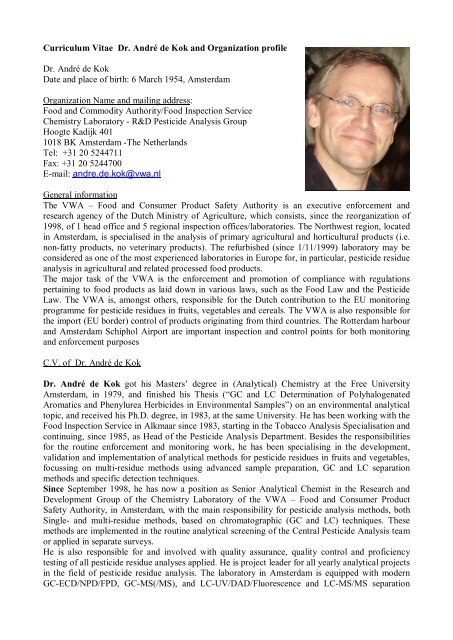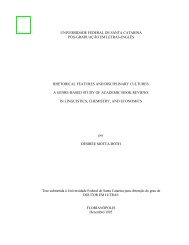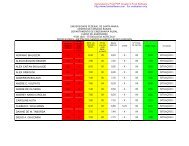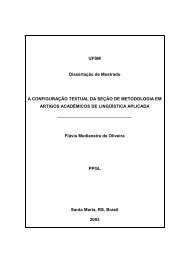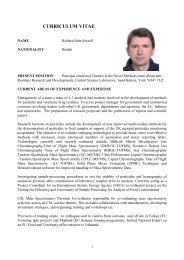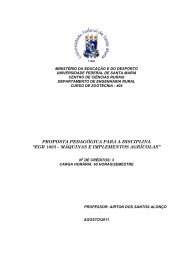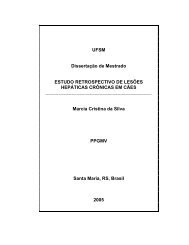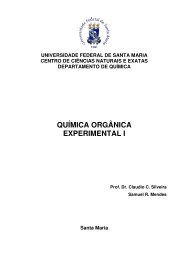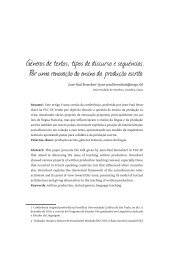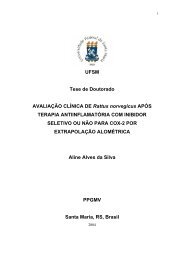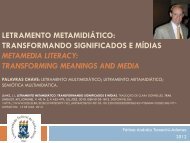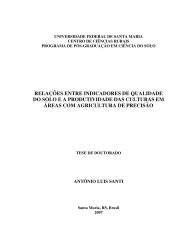Dr. André de Kok
Dr. André de Kok
Dr. André de Kok
Create successful ePaper yourself
Turn your PDF publications into a flip-book with our unique Google optimized e-Paper software.
Curriculum Vitae <strong>Dr</strong>. <strong>André</strong> <strong>de</strong> <strong>Kok</strong> and Organization profile<br />
<strong>Dr</strong>. <strong>André</strong> <strong>de</strong> <strong>Kok</strong><br />
Date and place of birth: 6 March 1954, Amsterdam<br />
Organization Name and mailing address:<br />
Food and Commodity Authority/Food Inspection Service<br />
Chemistry Laboratory - R&D Pestici<strong>de</strong> Analysis Group<br />
Hoogte Kadijk 401<br />
1018 BK Amsterdam -The Netherlands<br />
Tel: +31 20 5244711<br />
Fax: +31 20 5244700<br />
E-mail: andre.<strong>de</strong>.kok@vwa.nl<br />
General information<br />
The VWA – Food and Consumer Product Safety Authority is an executive enforcement and<br />
research agency of the Dutch Ministry of Agriculture, which consists, since the reorganization of<br />
1998, of 1 head office and 5 regional inspection offices/laboratories. The Northwest region, located<br />
in Amsterdam, is specialised in the analysis of primary agricultural and horticultural products (i.e.<br />
non-fatty products, no veterinary products). The refurbished (since 1/11/1999) laboratory may be<br />
consi<strong>de</strong>red as one of the most experienced laboratories in Europe for, in particular, pestici<strong>de</strong> residue<br />
analysis in agricultural and related processed food products.<br />
The major task of the VWA is the enforcement and promotion of compliance with regulations<br />
pertaining to food products as laid down in various laws, such as the Food Law and the Pestici<strong>de</strong><br />
Law. The VWA is, amongst others, responsible for the Dutch contribution to the EU monitoring<br />
programme for pestici<strong>de</strong> residues in fruits, vegetables and cereals. The VWA is also responsible for<br />
the import (EU bor<strong>de</strong>r) control of products originating from third countries. The Rotterdam harbour<br />
and Amsterdam Schiphol Airport are important inspection and control points for both monitoring<br />
and enforcement purposes<br />
C.V. of <strong>Dr</strong>. <strong>André</strong> <strong>de</strong> <strong>Kok</strong><br />
<strong>Dr</strong>. <strong>André</strong> <strong>de</strong> <strong>Kok</strong> got his Masters’ <strong>de</strong>gree in (Analytical) Chemistry at the Free University<br />
Amsterdam, in 1979, and finished his Thesis (“GC and LC Determination of Polyhalogenated<br />
Aromatics and Phenylurea Herbici<strong>de</strong>s in Environmental Samples”) on an environmental analytical<br />
topic, and received his Ph.D. <strong>de</strong>gree, in 1983, at the same University. He has been working with the<br />
Food Inspection Service in Alkmaar since 1983, starting in the Tobacco Analysis Specialisation and<br />
continuing, since 1985, as Head of the Pestici<strong>de</strong> Analysis Department. Besi<strong>de</strong>s the responsibilities<br />
for the routine enforcement and monitoring work, he has been specialising in the <strong>de</strong>velopment,<br />
validation and implementation of analytical methods for pestici<strong>de</strong> residues in fruits and vegetables,<br />
focussing on multi-residue methods using advanced sample preparation, GC and LC separation<br />
methods and specific <strong>de</strong>tection techniques.<br />
Since September 1998, he has now a position as Senior Analytical Chemist in the Research and<br />
Development Group of the Chemistry Laboratory of the VWA – Food and Consumer Product<br />
Safety Authority, in Amsterdam, with the main responsibility for pestici<strong>de</strong> analysis methods, both<br />
Single- and multi-residue methods, based on chromatographic (GC and LC) techniques. These<br />
methods are implemented in the routine analytical screening of the Central Pestici<strong>de</strong> Analysis team<br />
or applied in separate surveys.<br />
He is also responsible for and involved with quality assurance, quality control and proficiency<br />
testing of all pestici<strong>de</strong> residue analyses applied. He is project lea<strong>de</strong>r for all yearly analytical projects<br />
in the field of pestici<strong>de</strong> residue analysis. The laboratory in Amsterdam is equipped with mo<strong>de</strong>rn<br />
GC-ECD/NPD/FPD, GC-MS(/MS), and LC-UV/DAD/Fluorescence and LC-MS/MS separation
and <strong>de</strong>tection systems. The pestici<strong>de</strong> laboratory in Amsterdam has been assigned as National<br />
Reference Laboratory for pestici<strong>de</strong> residues, in The Netherlands.<br />
<strong>Dr</strong>. De <strong>Kok</strong> has been author and/or co-author of more than 25 papers in scientific journals and has<br />
presented many lectures and posters at international symposia and workshops.<br />
<strong>Dr</strong>. De <strong>Kok</strong> was the chairman of the 1st European Pestici<strong>de</strong> Residue Workshop (EPRW’96), held in<br />
Alkmaar, The Netherlands, June 1996. He is still a member of the Scientific Organising Committee<br />
of the biannual EPRW.<br />
<strong>Dr</strong>. De <strong>Kok</strong> has cooperated in a EU Quality Control Project resulting in an EU document “Quality<br />
Control Procedures for Pestici<strong>de</strong> Residues Analysis” (Gui<strong>de</strong>lines for Residues Monitoring in the<br />
EU), that has been revised biannually and he was a member of the scientific/organising committee<br />
of EU Workshops on Coordinated Analytical Quality Control (for Pestici<strong>de</strong> Residue Analysis),<br />
held in Oeiras (Lisbon), Portugal (September 1997), Athens, Greece (November 1999), York, UK<br />
(July 2003) and Stockholm, Swe<strong>de</strong>n (December 2005).<br />
<strong>Dr</strong>. De <strong>Kok</strong> is also a member of the Advisory and Scientific Committee for EU Proficiency Testing<br />
for EU Member State laboratories submitting pestici<strong>de</strong> residue data as part of the EU Monitoring<br />
programme for pestici<strong>de</strong> residues in fruits and vegetables.<br />
<strong>Dr</strong>. De <strong>Kok</strong> has been participating in two other EU SMT projects on “Organophosphorus Pestici<strong>de</strong>s<br />
in Cereals” and “Intercomparison study of three CEN extraction methods for pestici<strong>de</strong> residue<br />
analysis’, respectively, and he has co-organised two collaborative studies for the validation of<br />
(draft) CEN-standardised methods for the analysis of N-methylcarbamate pestici<strong>de</strong>s and<br />
benzimidazole fungici<strong>de</strong>s, respectively. Both methods were <strong>de</strong>veloped in the Pestici<strong>de</strong> Analysis<br />
Department of the former Alkmaar Food Inspection Service (now VWA).<br />
He is participating as an governmental liason, experienced pestici<strong>de</strong> analysis laboratory in a 2-year<br />
EU Alfa-programme project “EUROLANTRAP” (The <strong>de</strong>velopment of fast and cost-effective<br />
harmonized analytical methods for the <strong>de</strong>termination of pestici<strong>de</strong>s residues in fruits, vegetables and<br />
cereals, to be applied for import and export control, in or<strong>de</strong>r to reduce tra<strong>de</strong> barriers and the health<br />
risks for consumers) between 3 Latin-American and 3 European universities, promoting the<br />
exchange of Professors, tutors,Master and Ph.D. stu<strong>de</strong>nts between LA and Europe.<br />
He was co-author of the well-known Dutch Manual “Analytical Methods for Pestici<strong>de</strong> Residues in<br />
Foodstuffs” (6 th Edition, 1996, General Inspectorate for Health Protection, The Hague, The<br />
Netherlands), to which his laboratory contributed many advanced multi-residue methods.<br />
Most recent literature references:<br />
1. A. <strong>de</strong> <strong>Kok</strong>, M. Hiemstra and C.P. Vreeker<br />
Improved cleanup method for the multiresidue analysis of N-methylcarbamates in grains, fruits and<br />
vegetables by means of HPLC with post-column reaction and fluorescence <strong>de</strong>tection<br />
Chromatographia, 24 (1987) 469-476.<br />
2. A . <strong>de</strong> <strong>Kok</strong>, M. Hiemstra and C.P. Vreeker<br />
Optimization of the postcolumn hydrolysis reaction on solid phases for the routine high-performance liquid<br />
chromatographic <strong>de</strong>termination of N-methylcarbamate pestici<strong>de</strong>s in food products<br />
J. Chromatogr., 507 (1990) 459-472.<br />
3. A. <strong>de</strong> <strong>Kok</strong>, M. Hiemstra and U. A. Th. Brinkman<br />
Low ng/l-level <strong>de</strong>termination of twenty N-methylcarbamate pestici<strong>de</strong>s and twelve of their polar metabolites<br />
in surface water via off-line solid-phase extraction and high-performance liquid chromatography with postcolumn<br />
reaction and fluorescence <strong>de</strong>tection<br />
J. Chromatogr., 623 (1992) 265-276.<br />
4. A. <strong>de</strong> <strong>Kok</strong> and M. Hiemstra<br />
Optimization, automation, and validation of the solid-phase extraction cleanup and on-line liquid<br />
chromatographic <strong>de</strong>termination of N-methylcarbamates in fruits and vegetables<br />
J. AOAC Int., 75 (1992) 1063-1072.
5. M. Hiemstra and A. <strong>de</strong> <strong>Kok</strong><br />
Determination of N-methylcarbamate pestici<strong>de</strong>s in environmental water samples using automated on-line<br />
trace enrichment with exchangeable cartridges and high-performance liquid chromatography<br />
J. Chromatogr., 667 (1994) 155-166.<br />
6. A. <strong>de</strong> <strong>Kok</strong><br />
Multiresidue methods used in The Netherlands and residue data obtained in 1993<br />
Proceedings of the 3rd International Seminar on Pestici<strong>de</strong> Residues, Almeria, Spain (1994), 87-113.<br />
7. A. <strong>de</strong> <strong>Kok</strong>, C.P. Vreeker, E.W. Besamusca, A.A. Toonen and M. Hiemstra<br />
“Evaluation, validation and practical application of GC-ITD for routine pestici<strong>de</strong> residue analysis in fruits<br />
and vegetables”,<br />
in: ‘Current Status and Future Trends in Analytical Food Chemistry”, Proceedings of the Eighth European<br />
Conference on Food Chemistry (Euro Food Chem VIII), Vienna, Austria (1995), Volume 2, 415-418.<br />
8. M. Hiemstra, J. A. Joosten and A. <strong>de</strong> <strong>Kok</strong><br />
Fully automated solid-phase extraction cleanup and on-line liquid chromatographic <strong>de</strong>termination of<br />
benzimidazole fungici<strong>de</strong>s in fruit and vegetables<br />
J. AOAC Int., 78 (1995) 1267-1274.<br />
9. Co-author of: “Analytical Methods for Pestici<strong>de</strong> Residues in Foodstuffs”, 6th edition (1996), Inspectorate<br />
for Health Protection, Ministry of Health, Welfare and Sports, The Hague, The Netherlands.<br />
10. M. Hiemstra, A.A Toonen and A. <strong>de</strong> <strong>Kok</strong><br />
Determination of benzoylurea insectici<strong>de</strong>s in pome fruit and fruiting vegetables using liquid chromatography<br />
with dio<strong>de</strong> array <strong>de</strong>tection, and residue data obtained in the Dutch national monitoring program<br />
J. AOAC Intern., 82 (1999) 1198-1205.<br />
11. M. Hiemstra and A. <strong>de</strong> kok<br />
Determination of pestici<strong>de</strong>s using liquid chromatography-mass spectrometry;<br />
I. Analytical method for imidacloprid – Survey of agricultural products<br />
De Ware(n)-Chemicus, 31(2001)115-128.<br />
12. M. Hiemstra and A. <strong>de</strong> kok<br />
Determination of pestici<strong>de</strong>s using liquid chromatography-mass spectrometry;<br />
II. Analytical method for propamocarb – Survey of agricultural products<br />
De Ware(n)-Chemicus, 31(2001)215-227.<br />
13. M. Hiemstra and A. <strong>de</strong> <strong>Kok</strong><br />
Determination of propamocarb in vegetables using polymer-based high-performance liquid chromatography<br />
coupled with electrospray mass spectrometry<br />
J. Chromatogr. A, 972(2002)231-239.<br />
14. S.J. Lehotay, A. <strong>de</strong> <strong>Kok</strong>, M. Hiemstra, P. van Bo<strong>de</strong>graven, Validation of a Fast and Easy Method for the<br />
Determination of 229 Pestici<strong>de</strong> Residues in Fruits and Vegetables Using Gas and Liquid Chromatography<br />
and Mass Spectrometric Detection,<br />
J. AOAC Int. 88 (2005)595.<br />
15. A. Agüera and A. <strong>de</strong> <strong>Kok</strong>, in: A.R. Fernán<strong>de</strong>z-Alba (Ed.), Chromatographic - Mass Spectrometry Food<br />
Analysis for Trace Determination of Pestici<strong>de</strong> Residues, Vol. XLIII, Elsevier, Amsterdam, The Netherlands,<br />
2005, Chapter 7, GC-MS. II : Applications for pestici<strong>de</strong> analysis in food,p. 339-368.<br />
16. Ionara R. Pizzutti 1 , <strong>André</strong> <strong>de</strong> <strong>Kok</strong> 2 , Renato Zanella 1* , Martha B. Adaime 1 , Maurice Hiemstra 2 , Cristine<br />
Wickert 1 and Osmar D. Prestes 1 , Method validation for the analysis of 169 pestici<strong>de</strong>s in soya grain, without<br />
clean up, by liquid chromatography-tan<strong>de</strong>m mass spectrometry using positive and negative electrospray<br />
ionization,<br />
J. Chromatogr. A, (2007) in press.


